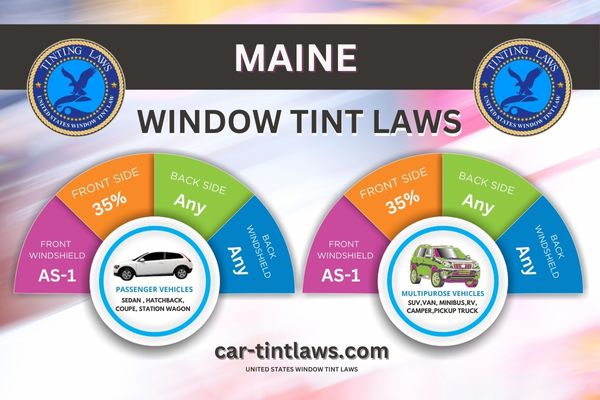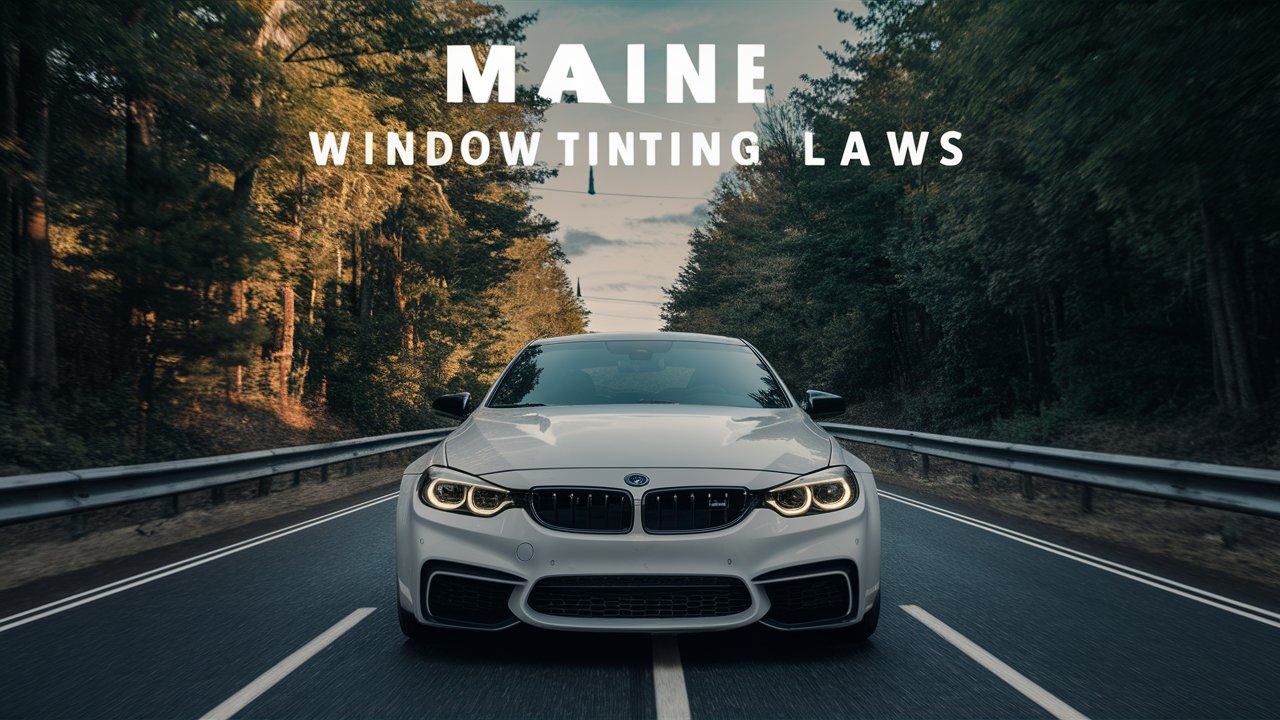Did you know that in Maine, the darkness of your car’s window tint can affect whether you get pulled over?
The state has specific regulations, such as allowing non-reflective tint only on the top 6 inches of the windshield and requiring front side windows to let in more than 65% of light.
Meanwhile, back side windows can have any level of darkness, but reflective tints are a no-go across the board.
There are even medical exemptions and required compliance stickers.
Curious about the consequences of not following these rules or how you can legally tint your windows? Let’s explore more.
Window Tint Darkness in Maine
When considering tint darkness for your vehicle in Maine, it’s important to know that the rules differ for sedans and SUVs or vans.
For sedans, front side windows must allow more than 35% of light to enter, whereas rear side windows can have any level of tint darkness.
This distinction guarantees compliance with state regulations, keeping you informed and within legal limits.
Tint darkness for sedans:
- Windshield: Non-reflective tint is allowed above AS-1 line or top 5 inches of the windshield.
- Front Side windows: Must allow more than 35% of light in.
- Back Side windows: Must allow more than 35% of light in; no restrictions on vehicles with outside rear view mirrors on each side.
- Rear Window: Any darkness of tint is allowed.
Tint darkness for SUV and Vans:
- Windshield: Non-reflective tint is allowed on the top 6 inches of the windshield.
- Front Side windows: Must allow more than 35% of light in.
- Back Side windows: Any shade can be used.
- Rear window: Must allow more than 35% of light in; no restrictions on vehicles with outside rear view mirrors on each side.
Window Tint Reflection in Maine
In Maine, the rules for window tint reflection are strict, applying uniformly to sedans, SUVs, and vans.
Reflective tint is completely prohibited on both the front and back side windows, ensuring that no glare impairs the driver’s visibility.
This regulation helps maintain safety on the roads and allows law enforcement to easily check compliance with tint darkness levels.
Tint reflection for sedans:
- Front Side windows: Must not be more than 20% reflective.
- Back Side windows: Must not be more than 20% reflective.
Tint reflection for SUV and vans:
- Front Side windows: Reflective tint is strictly prohibited.
- Back Side windows: Reflective properties are not allowed, but any darkness of tint is acceptable as long as it is non-reflective.
Other Maine window tint rules and regulations
- Side Mirrors: No restrictions.
- Restricted Colors: In Maine, all tint colors are permitted.
- Certificates: Manufacturers of film need to certify the film they sell in the state. Ask your dealer if they are using certified film.
- Stickers: The sticker/label of compliance to identify legal tinting is required between the film & glass on each tinted window.
- Medical Exceptions: Maine permits medical exemptions for special tint. For more details about the specific terms of the exemption, consult ME state law.
- Penalties: Maximum fine of $137 for first conviction. Subsequent offenses can result in higher fines and potentially vehicle inspection failure.

Medical Exemptions for Window Tint Rules in Maine
Maine’s window tinting laws provide medical exemptions for individuals with specific conditions like albinism, lupus, porphyria, or photophobia, safeguarding their safety and comfort.
If you have one of these conditions, Maine window tint laws allow for certain flexibility.
To qualify for a medical exemption, you’ll need a medical certification from a licensed physician.
This certification must clearly state that tinted windows are necessary for your condition.
When driving, it’s crucial to carry this medical certification in your vehicle at all times.
The State Police may request to see your certification to verify that you are legally allowed to have tinted windows that might otherwise violate standard rules.
Visible light transmission (VLT) requirements, which typically limit how dark your windows can be, are adjusted for those with valid medical exemptions.
These exemptions are vital for individuals with specific health needs, providing them with the necessary protection from harmful sunlight.
By ensuring you have the proper documentation and understanding the laws, you can benefit from the flexibility offered by Maine’s window tinting regulations.
Remember, adhering to these requirements not only safeguards your safety but also helps maintain compliance with state laws.
Maine Window Tint Ticket Cost
You’ll find that the minimum penalty for a window tint violation in Maine is $100.
However, this penalty can increase depending on the number of windows that are illegally tinted on your vehicle.
Each additional window with illegal tint can add to the overall tint ticket cost, making it considerably higher.
Given this, it’s evident that the cost of a tint ticket can quickly exceed the price of a legal tint installation.
Legal tint installation ensures that your vehicle complies with Maine tint laws, helping you avoid any unnecessary fines.
Adherence to these laws is essential in Maine, as police officers are vigilant and can issue fines for illegal window tint during routine traffic stops.
Investing in legal tint installation not only saves you from the immediate financial burden of fines but also from potential future expenses related to repeated violations.
Keeping your vehicle in line with Maine tint regulations fosters a sense of belonging within the community, as you adhere to state laws designed for everyone’s safety.
By staying informed and compliant, you contribute to a safer driving environment for all.
Maine State Overview
Maine’s window tinting laws outline specific guidelines for legal tint darkness, reflectivity limits, and additional regulations.
You must make sure your front side windows allow at least 35% light transmittance, while rear side and rear windows can be as dark as you prefer.
Reflective tints are not allowed, and law enforcement can inspect your window tint levels to verify compliance.
Legal Tint Darkness
When tinting your vehicle’s windows in Maine, it’s essential to know that the front side windows must allow more than 35% of light to pass through.
This requirement is based on the VLT (Visible Light Transmittance) percentage, which measures the amount of light that can penetrate the window film and glass.
Understanding these window tinting laws is vital to guarantee your vehicle’s tint complies with state regulations and to avoid any potential fines.
In addition to the front side windows, Maine’s window tinting laws specify that rear side windows and rear windows can have any darkness of tint.
This means you have more flexibility when it comes to the back of your vehicle.
However, keep in mind that the windshield must remain largely clear, with any tinting allowed only above the AS-1 line, which is generally the top part of the windshield.
Law enforcement officers in Maine have tools to measure VLT and ensure adherence to these legal window tint standards.
Staying within these limits is crucial to avoid penalties and violations.
By adhering to these guidelines, you can enjoy the benefits of tinted windows while staying within the legal boundaries.
Reflectivity Limits
Reflective tint on the front and back side windows in Maine is prohibited to guarantee driver visibility and road safety.
This regulation ensures that drivers have a clear view of their surroundings, which is crucial for preventing accidents and enhancing overall road safety.
The prohibition of reflective elements in tints on these windows is strictly enforced by Maine law enforcement officers.
They use specialized instruments to measure the amount of light passing through your vehicle’s windows, ensuring compliance with the state’s regulations.
Reflective tints can be used on the rear windows, provided they meet the state’s visible light transmission requirements.
These requirements are in place to balance your privacy and security while maintaining sufficient visibility for safe driving.
It’s vital to adhere to these rules to avoid fines, penalties, and complications during vehicle inspections.
Law enforcement officers are diligent in their enforcement of these reflectivity limits, and staying within legal bounds can save you from unnecessary hassles.
Additional Regulations
In addition to the reflectivity limits, there are several other regulations you should be aware of to guarantee your vehicle’s window tinting is fully compliant with Maine state laws.
Maine regulations stipulate that the front side windows must allow at least 35% light transmission, known as VLT (Visible Light Transmittance).
This guarantees sufficient visibility for both drivers and law enforcement officers.
Reflective tint is strictly prohibited on all windows in Maine.
This rule helps maintain safety by reducing glare and prevents excessive reflection that could distract other drivers.
Additionally, Maine law recognizes the need to allow medical exemptions for individuals with specific conditions such as albinism or photophobia.
If you qualify, you’ll need to obtain proper documentation to be presented upon request.
Another important regulation involves the requirement for dual outside rear view mirrors if the back window of your vehicle is tinted.
This ensures that you maintain adequate visibility of the road behind you, compensating for the reduced transparency of the rear window.
Finally, manufacturers must certify that the window tint film they sell in Maine meets state regulations, ensuring that your purchase is compliant with local laws.
By following these guidelines, you can guarantee your vehicle remains within legal standards.
References
Maine Statutes Title 29A section 1916: Reflective and tinted glass
Frequently Asked Questions
What Is the Darkest Legal Tint in Maine?
You can’t tint your front side windows darker than 35% in Maine. Benefits include clearer visibility, but limitations exist for safety.
Exceptions for rear windows allow any darkness. Enforcement’s strict, so stay informed to avoid penalties.
What Medical Conditions Qualify for Window Tint in Maine?
Imagine sunlight as a relentless invader. If you’ve got eye conditions or skin conditions like lupus or even cancer, light sensitivity is real. With a dermatologist or ophthalmologist’s approval, you can get a tint exemption.
What State Has the Darkest Tint Law?
You’ll find the darkest tint law in Vermont, not California tint laws, Florida tint shades, Texas window tinting, or Arizona tint regulations.
Vermont allows only 24% VLT on rear windows, prioritizing safety and visibility.
What Is the Legal Tint in New Hampshire?
Imagine driving with sunglasses on a cloudy day. In New Hampshire, your front side windows need over 35% tint percentage, but back sides can be darker.
Medical exemptions exist, and enforcement policies prioritize safety concerns.
Conclusion
Understanding Maine’s window tinting laws is like traveling a well-marked road; with clear guidelines for darkness, reflection, and necessary documentation, you can drive confidently without facing fines.
Remember, front side windows must allow over 65% light, while non-reflective tint on the top 6 inches of the windshield is acceptable.
Violating these rules can lead to fines starting at $100, so stay informed and compliant.
Following these regulations guarantees a smooth journey in Maine.
